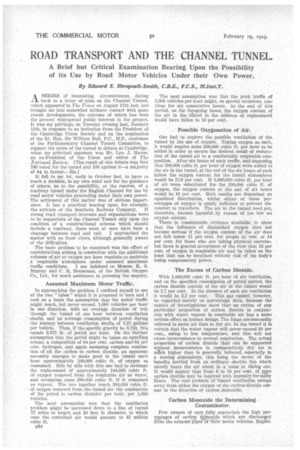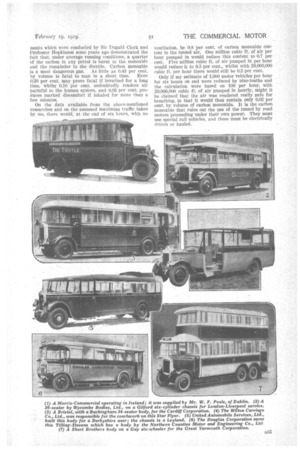ROAD TRANSPORT AND THE CHANNEL TUNNEL.
Page 140

Page 141

If you've noticed an error in this article please click here to report it so we can fix it.
A Brief but Critical Examination Bearing Upon the Possibility of its Use by Road Motor Vehicles Under their Own Power.
By Edward S. Shrapnell-Smith, C.B.E., F.C.S., M.Inst.T.
A SERIES of interesting circumstances, dating _LI_ back to a letter of mine on the Channel Tunnel, which appeared', in The Times on August 17th last, has brought me into somewhat intimate contact with more recent developments, the outcome of which has been the present widespread public interest in the project. It was my privilege, on Tuesday evening last, January 12th, in response to an invitation from the President of the Cambridge Union Society and on the nomination of the Rt. Hon. Sir William Bull, P.C., M.P., chairman of the Parliamentary Channel Tunnel Committee, to support the cause of the tunnel in debate at Cambridge, when my principal opponent was Mr. Leo. J. 11Iaxse, an ex-President of the Union and editor of The . tional Review. [The result of this debate was that 190 voted for the tunnel and 106 against it—a majority of 84 in favour.—En.] It fell to my lot, early in October last, to have to reach a decision, in my own mind and for the guidance of others, as to the passibility,, or the reverse, of a roadway tunnel under the English Channel for use by road motor vehicles proceeding tinder their own power. The settlement of this matter was of obvious importance,It has a practical bearing upon, for example, the attitude of the. Southern Railway Company. If strong road transport interests and organizations were to be supporters of the Channel Tunnel only upon the condition of a constructional scheme which should include a roadway, there must at once have been a cleavage between road and rail. I approached the matter with no fixed views, although generally aware of the difficulties.'
The basic problem to be examined was the effect of considerations arising in connection with the additional volumes of air or oxygen per hour requisite to maintain . a respirable atmosphere under assumed maximum traffic conditions. I am indebted -to Messrs. K. S. . Murray and C. R. Houseman, of the British Oxygen Co., Ltd., for much assistance in pursuing the enquiry.
Assumed Maximum Motor Traffic; In approaching the problem I confined myself to nne of the two " tubes " which it is proposed to bore and I took as a basis the assumption that the motof traffic might reach, but never exceed. 1,000. vehicles per hour In one direction, with an avetage duration of trip through the tunnel of . one hour between ventilation shafts, and an average .cortenimption of petrol during the journey between ventilation shafts of 1.25 galkins per Vehicle. Thus, if the specific gravity be 0.750, this equals 9.375 lb. of ,petrol per. hour. On the further assumption that the, petrol might be taken as equalling octane, a composition of 84 per cent, carbon and.16 per cent hydrogen, and. again assuming complete. combus tion of all the carbon tocarbon dioxide, an apparent _ necessity emerges to make goad in the tunnel each hour apProximately 240,000 Cubic ft. of oxygen so consumed: Side by side with:this one had to envisage the replacement of approximately 144,000 cubic ft. of oxygen removed from the respirable air as Water, and occupying some 288,000 cubit, ft. if it remained as vapour. The two together reach 384,000 cubic ft. of oxygen removed from the tunnel air_ (by. combustion
. of the petrol to carbon dioxide) per hour, per 1,000 vehicles.
The next assumption was that the ventilation problem might be narrowed down to a line of tunnel 27 miles in length and 20 feet in diameter, in which case the contained air would amount to 45 million cubic ft.
n34 The next assumption was that the peak traffic of 1,000 vehicles per hour might, on special occasions, continue for six consecutive hours. At the end of this period, on the foregoing bases, the oxygen content of the air in the tifnuel in the absence of replacement would have fallen to 16 per cent.
Possible Oxygenation of Air.
One had to explore the possible ventilation of the tunnel by the use of oxygen. Taking oxygen as such, it would require some 200,000 cubic ft. per hour to ho added in order to secure the desired result of restoration of the tunnel air to a comfortably respirable composition. After, six hours of such traffic, and supposing that 200,000 cubic ft. per hour of oxygen were added to the air in the tunnel, at the end of the six hours of such inflow the oxygen content for the tunnel atmosphere would be 17.8 per cent. If 1,000,000 cubic ft. per hour of air were substituted for the 200,000 cubic ft. of oxygen, the oxygen content at the end of six hours would be 16 per cent. Both results are dependent on equalized distribution, whilst either of these percentages of oxygen is amply sufficient to prevent discomfort to travellers. The air in the tunnel need not, therefore, become harmful by reason of too low an oxygen content.
There is considerable evidence available: to show that the influence of diminished oxygen does not become serious if the oxygen content of the air" does not fall below 11 per cent, for people at rest, or 14 per cent, for those who are taking physical exercise. but there is general acceptance of the view that 13 per cent. of oxygen in respirable air may be taken .as the least that can be breathed without risk of the body's losing compensatory power.
The Excess of Carbon Dioxide.
With 1,000,000 cubic ft. per hour of air ventilation, and on the specified consumption of petrotquoted, the carbon dioxide content of the air in the tunnel would be 2.7 per cent. In the absence of such air ventilation it would be 3.2 per cent. This gas cannot, however, he regarded merely on percentage data,. because the results of investigations show that'an excess of any particular proportion 'of carbon dioxide in conjUncthin with water vapour in respirable air has a more serious effect on human beings. The lungs are less easily relieved in moist air than in dry air. In the tunnel it is certain that the water vapour will never exceed 30 per cent., owing to low temperature, and . this will not cause inconvenience to normal respiration. The actual proportion of carbon dioxide that can be supported without inconvenience in comparatively dry air is rach higher than is generally believed, especially in a mewing atmosphere, this being the secret of the benefits deriVed frOrn an ordinary electric fan which merely beats the air about in a room or dining car. It would aptYear that from 8 to 10 per cent, of pare carbon dioxide May be inspired with impunity for many lours. The real problem of -tunnel ventilation swings away from either the oxygen or the carbon-dioxide content in the direction of carbon monoxide.
Carbon Monoxide the Determining Contaminator.
Few owners of cars fully appreciate the high percentages of carbon ilionexide which. are discharged from the exhaust Pines *-of Weir motor vehicles. ExpZri
meats which were conducted by Sir Dugald Clerk and Professor Hopkinson some years ago demonstrated the fact that, under average running conditions, a quarter of the carbon in any petrol is burnt to the monoxide and the remainder to the dioxide. Carbon monoxide is a most dangerous gas. As little as 0.43 per cent. by volume is fatal to man in a short time. Even 0.20 per cent. may prove fatal if breathed for a long time, whilst 0.10 per cent. undoubtedly renders air harmful to the human system, and 0.03 per cent. produces marked discomfort if inhaled for more than a few minutes.
On the data available from the above-mentioned researches and on the assumed maximum traffic taken by me, there would, at the end of six hours, with no ventilation, be 0.8 per cent, of carbon monoxide content in the tunnel air. One million cubic ft. of air per hour pumped in would reduce this content to 0.7 per cent. Five million cubic ft. of air pumped in per hour would reduce it to 0.5 per cent., whilst with 20,000,000 cubic ft. per hour there would still be 0,2 per cent.
Only if my estimate of 1,000 motor vehicles per hour for six hours on end were reduced by nine-tenths and the calculation were based on 100 per hour, with .20,000,000 cubic ft. of air pumped in hourly, Might it be claimed that the air was rendered really safe for breathing, in that it would then contain only 0.02 per cent. by volume of carbon monoxide. It is the carbon monoxide that rules out the use of the tunnel by road motors proceeding under their own power. They must use special rail vehicles, and these must be electrically driven or hauled.




























































































































































































































